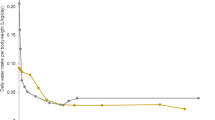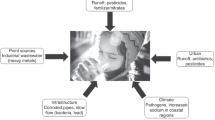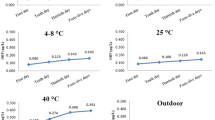Abstract
A variety of endocrine disrupting chemicals (EDCs), including some known to be obesogenic, can be found in household wastewater. Many are only partially treated by wastewater treatment and drinking water purification systems and can enter municipal drinking water supplies. We evaluated drinking water consumption habits in a cohort of obese pediatric patients to determine the percentage that might avoid exposure to EDCs from drinking municipal tap water. Obese (BMI ≥ 95th percentile) children presenting to an obesity clinic serving a largely poor and rural population were studied. Self-reported race/ethnicity, insurance status, and details concerning type and volume of water consumed were obtained from their medical records. Most homes were supplied with municipal, rather than private well water (90.6% vs. 9.4%, respectively). A majority (76.4%) of patients with municipal water as their water supply only drank bottled water. “Taste” and “Health Concerns” were the most commonly endorsed reasons for eschewing tap water. Bottled water consumption among low socioeconomic status patients may reduce their risk for exposure to EDCs in municipal tap water. Further studies are needed to confirm the generalizability of this observation.

Similar content being viewed by others
References
Anon (2017) North Carolina State Center for Health Statistics: Statistics and Reports: Health Atlas: BRFSS. NC Department of Health and Human Services, Raleigh, NC 27603-1392 http://www.schs.state.nc.us/schs/gis/atlas/PDFs/BRFSS_OvrWtObese10.pdf
Bach C, Dauchy X, Chagnon MC, Etienne S (2012) Chemical compounds and toxicological assessments of drinking water stored in polyethylene terephthalate (PET) bottles: a source of controversy reviewed. Water Res 46(3):571–583
Brodwin E, Pelisson A (2017) 17 facts that show why bottled water is one of the biggest scams of the century. http://www.businessinsider.com/bottled-water-facts-science-healthy-2017-4/#. Accessed 11 Oct 2017
Buerge IJ, Poiger T, Müller MD, Buser H-R (2003) Caffeine, an anthropogenic marker for wastewater contamination of surface waters. Environ Sci Technol 37:691–700
Clabby C (2016) From the air, environemntalists record flooded farms. North Carolina Health News 11/4/2016. https://www.northcarolinahealthnews.org/2016/10/25/post-matthew-water-how-bad-is-it/ Accessed 5 Oct 2017
De Coster S, van Larebeke N (2012) Endocrine-disrupting chemicals: associated disorders and mechanisms of action. J Environ Public Health Article ID 713696.1-51
de Jesus Gaffney V, Almeida CM, Rodrigues A, Ferreira E, Benoliel MJ, Cardoso VV (2015) Occurrence of pharmaceuticals in a water supply system and related human health risk assessment. Water Res 72:199–208
Del Rosario KL, Mitra S, Humphrey CP Jr, O’Driscoll MA (2014) Detection of pharmaceuticals and other personal care products in groundwater beneath and adjacent to onsite wastewater treatment systems in a coastal plain shallow aquifer. Sci Total Environ 487:216–223
Doria MF (2006) Bottled water versus tap water: understanding consumers’ preferences. J Water Health 4(2):271–276
Drewnowski A, Rehm CD, Constant F (2013) Water and beverage consumption among children age 4-13y in the United States: analyses of 2005-2010 NHANES data. Nutr J 12(1):85
Dupont D, Adamowicz WL, Krupnick A (2010) Differences in water consumption choices in Canada: the role of socio-demographics, experiences, and perceptions of health risks. J Water Health 8(4):671–676
Foltz F (1999) Science, pollution, and clean drinking water: choosing between tap water, bottled water, and home purification. Bull Sci Technol Soc 19(4):300–309
Forlenza S, Robinson A, Taft N, Kolasa K, Collier DN (2019) Excessive beverage consumption associated with significant financial burden: a quantitative study of obese pediatric patients’ drinking habits (in preparation)
Gatidou G, Thomaidis NS, Stasinakis AS, Lekkas TD (2007) Simultaneous determination of the endocrine disrupting compounds nonylphenol, nonylphenol ethoxylates, triclosan and bisphenol A in wastewater and sewage sludge by gas chromatography-mass spectrometry. J Chromatogr A 2008(1138):32–41
Gorelick MH, Gould L, Nimmer M, Wagner D, Heath M, Bashir H et al (2011) Perceptions about water and increased use of bottled water in minority children. Arc Pediatr Adol Med 165(10):928–932
Guart A, Bono-Blay F, Borrell A, Lacorte S (2014) Effect of bottling and storage on the migration of plastic constituents in Spanish bottled waters. Food Chem 156:73–80
Hager ER, Quigg AM, Black MM, Coleman SM, Heeren T, Rose-Jacobs R et al (2010) Development and validity of a 2-item screen to identify families at risk for food insecurity. Pediatr 126(1):e26–e32. https://doi.org/10.1542/peds.2009-3146
Hedrick VE, Savla J, Comber DL, Flack KD, Estabrooks PA, Nsiah-Kumi PA et al (2012) Development of a brief questionnaire to assess habitual beverage intake (BEVQ-15): sugar sweetened beverages and total beverage energy intake. J Acad Nutr Diet 112:840–849
Kolpin DW, Furlong ET, Meyer MT, Thurman EM, Zaugg SD, Barber LB, Buxton HT (2002) Pharmaceuticals, hormones, and other organic wastewater contaminants in U.S. streams, 1999–2000: a national reconnaissance. Environ Sci Technol 15(36):1202–1211
Levêque JG, Burns RC (2017) Predicting water filter and bottled water use in Appalachia: a community-scale case study. J Water and Health 15(3):451–461
Nguyen C, Stone K, Edwards M (2010) Case study of Greenville NC; coagulants and alkalinity. In: Nguyen C, Stone K, Clark B, Edwards M, Gagnon G, Knowles A (eds) Impact of chlorine: sulfate mass ratio (CSMR) on lead leaching in potable water. Water Research Foundation, Denver
Patel AI, Shapiro DJ, Wang YC, Cabana MD (2013) Sociodemographic characteristics and beverage intake of children who drink tap water. Am J Prev Med 45(1):75–82
Peng X, Ou W, Wang C, Wang Z, Huang Q, Jin J, Tan J (2014) Occurrence and ecological potential of pharmaceuticals and personal care products in groundwater and reservoirs in the vicinity of municipal landfills in China. Sci Total Environ 490:889–898
Pratt KJ, Lazorick S, Lamson AL, Ivanescu A, Collier DN (2013) Quality of life and BMI changes in youth participating in an integrated pediatric obesity treatment program. Health Qual Life Outcomes 11:116–124
Schaider LA, Rodgers KM, Rudel RA (2017) Review of organic wastewater compound concentrations and removal in onsite wastewater treatment systems. Environ Sci Tech 51:7304–7317
Schriks M, Heringa MB, van der Kooi MM, de Voogt P, van Wezel AP (2010) Toxicological relevance of emerging contaminants for drinking water quality. Water Res 44(2):461–476
Schwarzenbach RP, Escher BI, Fenner K, Hofstetter TB, Johnson CA, von Gunten U, Wehrli B (2006) The challenge of micropollutants in aquatic systems. Science 313(5790):1072–1077
Shotyk W, Krachler M (2007) Contamination of bottled waters with antimony leaching from polyethylene terephthalate (PET) increases upon storage. Environ Sci Tech 41:1560–1563
Sun M, Arevalo E, Strynar M, Lindstrom A, Richardson M, Kearns B et al (2016) Legacy and emerging perfluoroalkyl substances are important drinking water contaminants in the Cape Fear Watershed of North Carolina. Environ Sci Technol Lett 3(12):415–419
Swartz CH, Reddy S, Benotti MJ, Yin H, Barber LB, Brownawell BJ, Rudel RA (2006) Steroid estrogens, nonylphenol ethoxylate metabolites, and other wastewater contaminants in groundwater affected by a residential septic system on Cape Cod, MA. Environ Sci Technol 40(16):4894–4902
Taft N, Collier DN, Tanenberg R, Kolasa K (2015) How sweet it is: traditional sweet iced tea and the diabesity epidemic. Nutr Today 50(1):28–39
Walsh JP, Corbett R (2017) Storms to life. Renaissance Computing Institute at East Carolina University. https://www.ecu.edu/renci/stormstolife/about.html. Accessed 5 Oct 2017
Yang Y, Ok YS, Kim K-H, Kwon EE, Tsang YF (2017) Occurrences and removal of pharmaceuticals and personal care products (PPCPs) in drinking water and water/sewage treatment plants: a review. Sci Total Environ 596:303–320
Zivin JG, Neidell M, Schlenker W (2011) Water quality violations and avoidance behavior: evidence from bottled water consumption. Am Econ Rev 101(3):488-53
Funding
This research was supported in part via a grant from the National Institute of Environmental Health Sciences to North Carolina State University’s Center for Human Health and the Environment (P30ES025128, R. Smart PI).
Author information
Authors and Affiliations
Corresponding author
Ethics declarations
Conflict of interest
The authors declare they have no actual or potential conflicts of interest.
Ethical Approval
This study was approved by the University Medical Center Institutional Review Board (protocol 11-0422). All procedures performed in studies involving human participants were in accordance with the ethical standards of the institutional and/or national research committee and with the 1964 Helsinki declaration and its later amendments or comparable ethical standards. For this type of study formal consent is not required.
Additional information
Publisher's Note
Springer Nature remains neutral with regard to jurisdictional claims in published maps and institutional affiliations.
Rights and permissions
About this article
Cite this article
Collier, D.N., Robinson, A., Mitra, S. et al. Tapping Out: Influence of Organoleptic and Perceived Health Risks on Bottled Versus Municipal Tap Water Consumption Among Obese, Low Socioeconomic Status Pediatric Patients. Expo Health 12, 179–186 (2020). https://doi.org/10.1007/s12403-019-00302-2
Received:
Revised:
Accepted:
Published:
Issue Date:
DOI: https://doi.org/10.1007/s12403-019-00302-2




